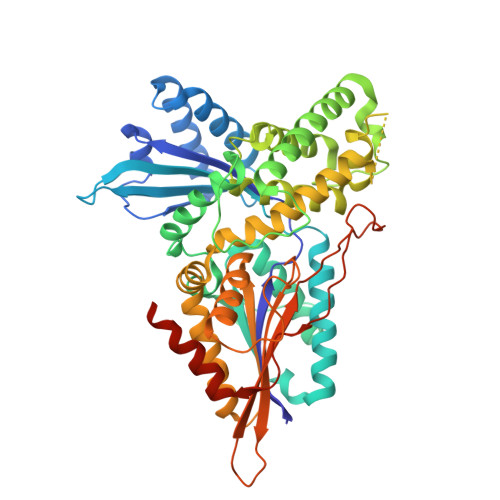A small signaling domain controls PPIP5K phosphatase activity in phosphate homeostasis.
Raia, P., Lee, K., Bartsch, S.M., Rico-Resendiz, F., Portugal-Calisto, D., Vadas, O., Panse, V.G., Fiedler, D., Hothorn, M.(2025) Nat Commun 16: 1753-1753
- PubMed: 39966396
- DOI: https://doi.org/10.1038/s41467-025-56937-0
- Primary Citation of Related Structures:
9GR8, 9GRH, 9GRN, 9GRO - PubMed Abstract:
Inositol pyrophosphates (PP-InsPs) are eukaryotic nutrient messengers. The N-terminal kinase domain of diphosphoinositol pentakisphosphate kinase (PPIP5K) generates the messenger 1,5-InsP 8 , the C-terminal phosphatase domain catalyzes PP-InsP breakdown. The balance between kinase and phosphatase activities regulates 1,5-InsP 8 levels. Here, we present crystal structures of the apo and substrate-bound PPIP5K phosphatase domain from S. cerevisiae (ScVip1 PD ). ScVip1 PD is a phytase-like inositol 1-pyrophosphate histidine phosphatase with two conserved catalytic motifs. The enzyme has a strong preference for 1,5-InsP 8 and is inhibited by inorganic phosphate. It contains an ¦Á-helical insertion domain stabilized by a structural Zn 2+ binding site, and a unique GAF domain that channels the substrate to the active site. Mutations that alter the active site, restrict the movement of the GAF domain, or change the substrate channel's charge inhibit the enzyme activity in vitro, and Arabidopsis VIH2 in planta. Our work reveals the structure, enzymatic mechanism and regulation of eukaryotic PPIP5K phosphatases.
Organizational Affiliation:
Structural Plant Biology Laboratory, Department of Plant Sciences, University of Geneva, Geneva, Switzerland.





















